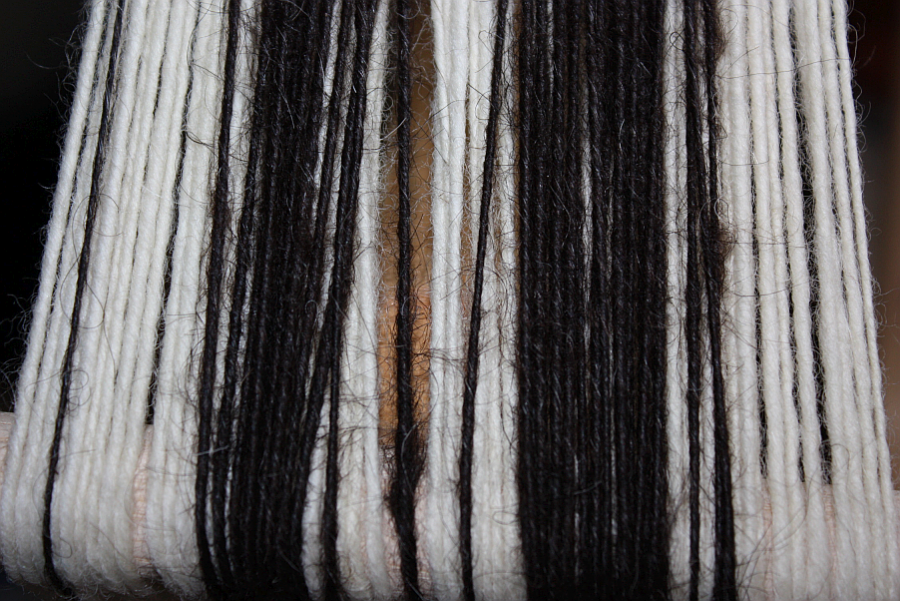Search the Blog
Latest Comments
Beatrix
Experiment!
23. April 2024
The video doesn´t work (at least for me). If I click on "activate" or the play-button it just disapp...
Katrin
Spinning Speed Ponderings, Part I.
15. April 2024
As far as I know, some fabrics do get washed before they are sold, and some might not be. But I can'...
Kareina
Spinning Speed Ponderings, Part I.
15. April 2024
I have seen you say few times that "no textile ever is finished before it's been wet and dried again...
Katrin
How on earth did they do it?
27. März 2024
Ah, that's good to know! I might have a look around just out of curiosity.
I've since learned that w...
Heather Athebyne
How on earth did they do it?
25. März 2024
...though not entirely easy. I've been able to get my hands on a few strands over the years for Geor...
Spinning!
There was some spinning today... in both black, and white. The reason for this is the exciting new and large project - recreating the finds (including the garments) that were found with the bog body of the Man from Bernuthsfeld (Wikipedia has an article about him, but only in German).
The body and the finds were off for research since 2011, but have returned last summer to the Landesmuseum Emden. The wish to show a better picture of the man, and how he might have looked in his lifetime, has led to this reconstruction project of the finds... which is totally awesome, and means a lot of (partly quite fiddly) work.
First step, after the extensive planning, is getting the fabrics. And, you might have guessed it - they are not your common garden-variety pieces, available without a problem in the next fabric shop. The tunic is put together from patches - more than 40! - and these patches are mostly from already worn fabrics, more than 20 different kinds.
Weaving small bits of fabric (a patch here, a patch there, patches, patches everywhere) is much less efficient than weaving a proper, large piece - which means that a lot of the planning was figuring out how large the individual pieces have to be, and how they can be woven without driving everybody involved utterly crazy.
The yarns are partly also a problem - which is the reason that I did a tiny bit of spinning. The rest of the yarns will be machine-spun, but as close to the original yarns as possible, and the weaving has already started. So exciting!
[caption id="attachment_3143" align="alignnone" width="442"] The yarn, dark and light - it is for a checkered patch that sits prominently on the breast of the tunic...
The yarn, dark and light - it is for a checkered patch that sits prominently on the breast of the tunic...
The body and the finds were off for research since 2011, but have returned last summer to the Landesmuseum Emden. The wish to show a better picture of the man, and how he might have looked in his lifetime, has led to this reconstruction project of the finds... which is totally awesome, and means a lot of (partly quite fiddly) work.
First step, after the extensive planning, is getting the fabrics. And, you might have guessed it - they are not your common garden-variety pieces, available without a problem in the next fabric shop. The tunic is put together from patches - more than 40! - and these patches are mostly from already worn fabrics, more than 20 different kinds.
Weaving small bits of fabric (a patch here, a patch there, patches, patches everywhere) is much less efficient than weaving a proper, large piece - which means that a lot of the planning was figuring out how large the individual pieces have to be, and how they can be woven without driving everybody involved utterly crazy.
The yarns are partly also a problem - which is the reason that I did a tiny bit of spinning. The rest of the yarns will be machine-spun, but as close to the original yarns as possible, and the weaving has already started. So exciting!
[caption id="attachment_3143" align="alignnone" width="442"]
 The yarn, dark and light - it is for a checkered patch that sits prominently on the breast of the tunic...
The yarn, dark and light - it is for a checkered patch that sits prominently on the breast of the tunic...Comments 5
Cathy Wycliff
on Donnerstag, 08. Juni 2017 02:09
Katrin
on Donnerstag, 08. Juni 2017 08:17
The original garment was put together from patches taken from already used fabrics, not from small woven patches - but for our reproduction, we have to use (and age) new fabrics, since we don't get used and worn early medieval type cloth fragments today.
As to "must have been tedious" - yes, that is probably true. We shall find out for ourselves once we get to that stage!
Cathy Wycliff
on Donnerstag, 08. Juni 2017 22:14



